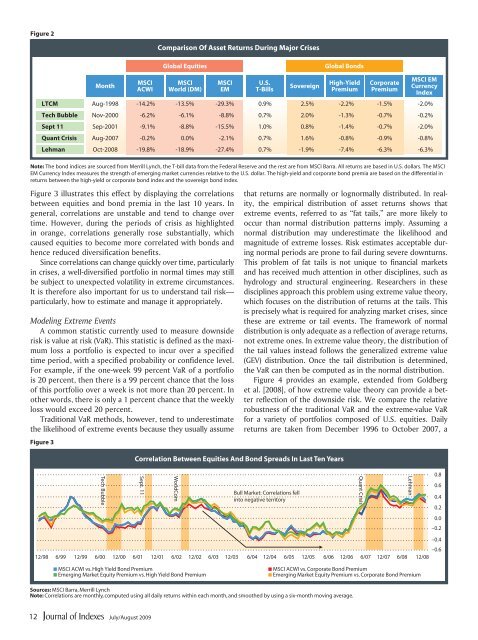How to Kill a Black Swan Remy Briand and David Owyong ...
How to Kill a Black Swan Remy Briand and David Owyong ...
How to Kill a Black Swan Remy Briand and David Owyong ...
You also want an ePaper? Increase the reach of your titles
YUMPU automatically turns print PDFs into web optimized ePapers that Google loves.
Figure 2<br />
Comparison Of Asset Returns During Major Crises<br />
Global Equities<br />
Global Bonds<br />
Month<br />
MSCI<br />
ACWI<br />
MSCI<br />
World (DM)<br />
MSCI<br />
EM<br />
U.S.<br />
T-Bills<br />
Sovereign<br />
High-Yield<br />
Premium<br />
Corporate<br />
Premium<br />
MSCI EM<br />
Currency<br />
Index<br />
LTCM Aug-1998 -14.2% -13.5% -29.3% 0.9% 2.5% -2.2% -1.5% -2.0%<br />
Tech Bubble Nov-2000 -6.2% -6.1% -8.8% 0.7% 2.0% -1.3% -0.7% -0.2%<br />
Sept 11 Sep-2001 -9.1% -8.8% -15.5% 1.0% 0.8% -1.4% -0.7% -2.0%<br />
Quant Crisis Aug-2007 -0.2% 0.0% -2.1% 0.7% 1.6% -0.8% -0.9% -0.8%<br />
Lehman Oct-2008 -19.8% -18.9% -27.4% 0.7% -1.9% -7.4% -6.3% -6.3%<br />
Note: The bond indices are sourced from Merrill Lynch, the T-bill data from the Federal Reserve <strong>and</strong> the rest are from MSCI Barra. All returns are based in U.S. dollars. The MSCI<br />
EM Currency Index measures the strength of emerging market currencies relative <strong>to</strong> the U.S. dollar. The high-yield <strong>and</strong> corporate bond premia are based on the differential in<br />
returns between the high-yield or corporate bond index <strong>and</strong> the sovereign bond index.<br />
Figure 3 illustrates this effect by displaying the correlations<br />
between equities <strong>and</strong> bond premia in the last 10 years. In<br />
general, correlations are unstable <strong>and</strong> tend <strong>to</strong> change over<br />
time. <strong>How</strong>ever, during the periods of crisis as highlighted<br />
in orange, correlations generally rose substantially, which<br />
caused equities <strong>to</strong> become more correlated with bonds <strong>and</strong><br />
hence reduced diversification benefits.<br />
Since correlations can change quickly over time, particularly<br />
in crises, a well-diversified portfolio in normal times may still<br />
be subject <strong>to</strong> unexpected volatility in extreme circumstances.<br />
It is therefore also important for us <strong>to</strong> underst<strong>and</strong> tail risk—<br />
particularly, how <strong>to</strong> estimate <strong>and</strong> manage it appropriately.<br />
Modeling Extreme Events<br />
A common statistic currently used <strong>to</strong> measure downside<br />
risk is value at risk (VaR). This statistic is defined as the maximum<br />
loss a portfolio is expected <strong>to</strong> incur over a specified<br />
time period, with a specified probability or confidence level.<br />
For example, if the one-week 99 percent VaR of a portfolio<br />
is 20 percent, then there is a 99 percent chance that the loss<br />
of this portfolio over a week is not more than 20 percent. In<br />
other words, there is only a 1 percent chance that the weekly<br />
loss would exceed 20 percent.<br />
Traditional VaR methods, however, tend <strong>to</strong> underestimate<br />
the likelihood of extreme events because they usually assume<br />
Figure 3<br />
that returns are normally or lognormally distributed. In reality,<br />
the empirical distribution of asset returns shows that<br />
extreme events, referred <strong>to</strong> as “fat tails,” are more likely <strong>to</strong><br />
occur than normal distribution patterns imply. Assuming a<br />
normal distribution may underestimate the likelihood <strong>and</strong><br />
magnitude of extreme losses. Risk estimates acceptable during<br />
normal periods are prone <strong>to</strong> fail during severe downturns.<br />
This problem of fat tails is not unique <strong>to</strong> financial markets<br />
<strong>and</strong> has received much attention in other disciplines, such as<br />
hydrology <strong>and</strong> structural engineering. Researchers in these<br />
disciplines approach this problem using extreme value theory,<br />
which focuses on the distribution of returns at the tails. This<br />
is precisely what is required for analyzing market crises, since<br />
these are extreme or tail events. The framework of normal<br />
distribution is only adequate as a reflection of average returns,<br />
not extreme ones. In extreme value theory, the distribution of<br />
the tail values instead follows the generalized extreme value<br />
(GEV) distribution. Once the tail distribution is determined,<br />
the VaR can then be computed as in the normal distribution.<br />
Figure 4 provides an example, extended from Goldberg<br />
et al. [2008], of how extreme value theory can provide a better<br />
reflection of the downside risk. We compare the relative<br />
robustness of the traditional VaR <strong>and</strong> the extreme-value VaR<br />
for a variety of portfolios composed of U.S. equities. Daily<br />
returns are taken from December 1996 <strong>to</strong> Oc<strong>to</strong>ber 2007, a<br />
Tech Bubble<br />
Correlation Between Equities And Bond Spreads In Last Ten Years<br />
Sept. 11<br />
WorldCom<br />
Bull Market: Correlations fell<br />
in<strong>to</strong> negative terri<strong>to</strong>ry<br />
12/98 6/99 12/99 6/00 12/00 6/01 12/01 6/02 12/02 6/03 12/03 6/04 12/04 6/05 12/05 6/06 12/06 6/07 12/07 6/08 12/08<br />
Quant Crisis<br />
Lehman<br />
0.8<br />
0.6<br />
0.4<br />
0.2<br />
0.0<br />
–0.2<br />
–0.4<br />
–0.6<br />
■ MSCI ACWI vs. High Yield Bond Premium<br />
■ Emerging Market Equity Premium vs. High Yield Bond Premium<br />
■ MSCI ACWI vs. Corporate Bond Premium<br />
■ Emerging Market Equity Premium vs. Corporate Bond Premium<br />
Sources: MSCI Barra, Merrill Lynch<br />
Note: Correlations are monthly, computed using all daily returns within each month, <strong>and</strong> smoothed by using a six-month moving average.<br />
12<br />
July/August 2009
















